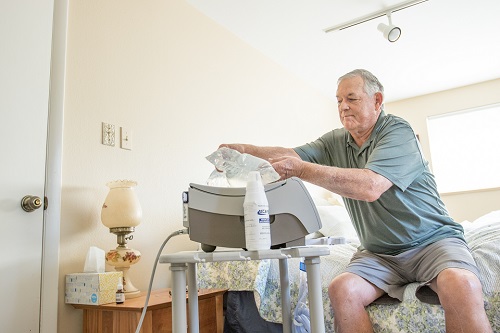Kidney Health 101: Peritoneal Dialysis Basics and Benefits

If you recently learned you need treatment for kidney failure, you may be glad to hear you have choices when it comes to dialysis. Here’s a look at peritoneal dialysis (PD) to help you decide if this is a treatment option you want to discuss with your doctor. Talking with your nephrologist or attending a Kidney Smart® class can help you better understand your treatment options.
How is PD different?
PD differs from other dialysis options in that it uses the body’s own abdominal lining (the peritoneum) to clean the blood rather than a synthetic filter (dialyzer). If you choose PD, you’ll need a PD catheter surgically placed, typically through your abdomen. Typically the catheter exit site is allowed to heal for a few weeks, before you begin PD treatments.
In addition to dialyzing in the comfort of your own home and the schedule flexibility to continue with work, school, hobbies and other interests, you may experience additional benefits from PD such as:
- A more flexible diet –With a greater variety of food options.
- Doorstep supplies – Get equipment delivered to your home or travel destination.
- Fewer center visits –Visit your dialysis center typically twice a month for checkups instead of several times a week.
- Fewer side effects – PD patients may experience fewer dialysis side effects, such as muscle cramps and unstable blood pressure.
- No needles – PD does not require the use of needles and instead uses a soft, flexible catheter to access the peritoneum.
- Better preservation of remaining kidney function
How does PD work?
With PD, the dialysis fluid is pushed by a machine or gravity through the catheter into your body where it pulls waste and fluids through the peritoneum into the peritoneal cavity (a space within the abdominal cavity). After four to six hours, called “dwell time,” waste products, extra fluid and the dialysate are drained through the catheter. Each drain-and-fill session is called an “exchange,” which usually takes 30 to 40 minutes.
You can do PD during the day or night. If you choose automated peritoneal dialysis (APD), you’ll start exchanges at night while you sleep with a machine called a cycler, and depending on the volume of urine you still make you may also do some daytime exchanges. If you choose continuous ambulatory peritoneal dialysis (CAPD), you’ll do exchanges throughout the day. Either type of PD allows for you to still be able to continue your normal daytime activities.
What support is available?
While PD offers greater independence, choosing PD doesn’t mean you’re on your own. You’ll receive thorough training, ongoing education and a care team available 24/7. You’ll also receive personalized support from your nephrologist, PD nurses, dietitian, social worker, insurance specialist and others.
Is PD right for you?
Your nephrologist can offer you more information about PD and help you decide if PD is the right dialysis modality for you. You can also visit DaVita’s PD page to learn more, including PD facts, what to expect on PD and stories from people on PD. Get started by checking out Cheri’s story here.
Additional Kidney Diet Resources
Visit DaVita.com and explore these diet and nutrition resources:
- DaVita Food Analyzer
- DaVita Dining Out Guides
- Today’s Kidney Diet Cookbooks
- DaVita Kidney-Friendly Recipes
- Diet and Nutrition Articles
- Diet and Nutrition Videos
- Kidney Smart® Virtual Classes
This article is for informational purposes only and is not a substitute for medical advice or treatment. Consult your physician and dietitian regarding your specific diagnosis, treatment, diet and health questions.

Recent Comments